Effective Entry Modes: International Companies in the Turkish Market
VerifiedAdded on 2020/05/28
|45
|13863
|1476
Report
AI Summary
This report delves into the critical topic of effective entry modes for international companies seeking to establish a presence in the Turkish market. It begins with an introduction to globalization and the dynamics of the Turkish market, highlighting both opportunities and challenges. The report then provides an overview of various entry modes, including exporting, licensing, franchising, strategic alliances, acquisitions, joint ventures, and greenfield ventures, discussing their respective advantages and disadvantages. The study further analyzes the Turkish market, acknowledging its unique regulatory environment and potential risks while emphasizing the significant opportunities it presents. Two case studies are presented, illustrating the application of acquisition and strategic alliance entry modes by international companies in Turkey. The report compares and contrasts these entry modes, evaluating their effectiveness and offering recommendations to international companies. The conclusion summarizes the key findings and provides guidance on selecting the most suitable entry modes for success in the Turkish market, considering the specific context and challenges of the region. References and a literature review are also included.
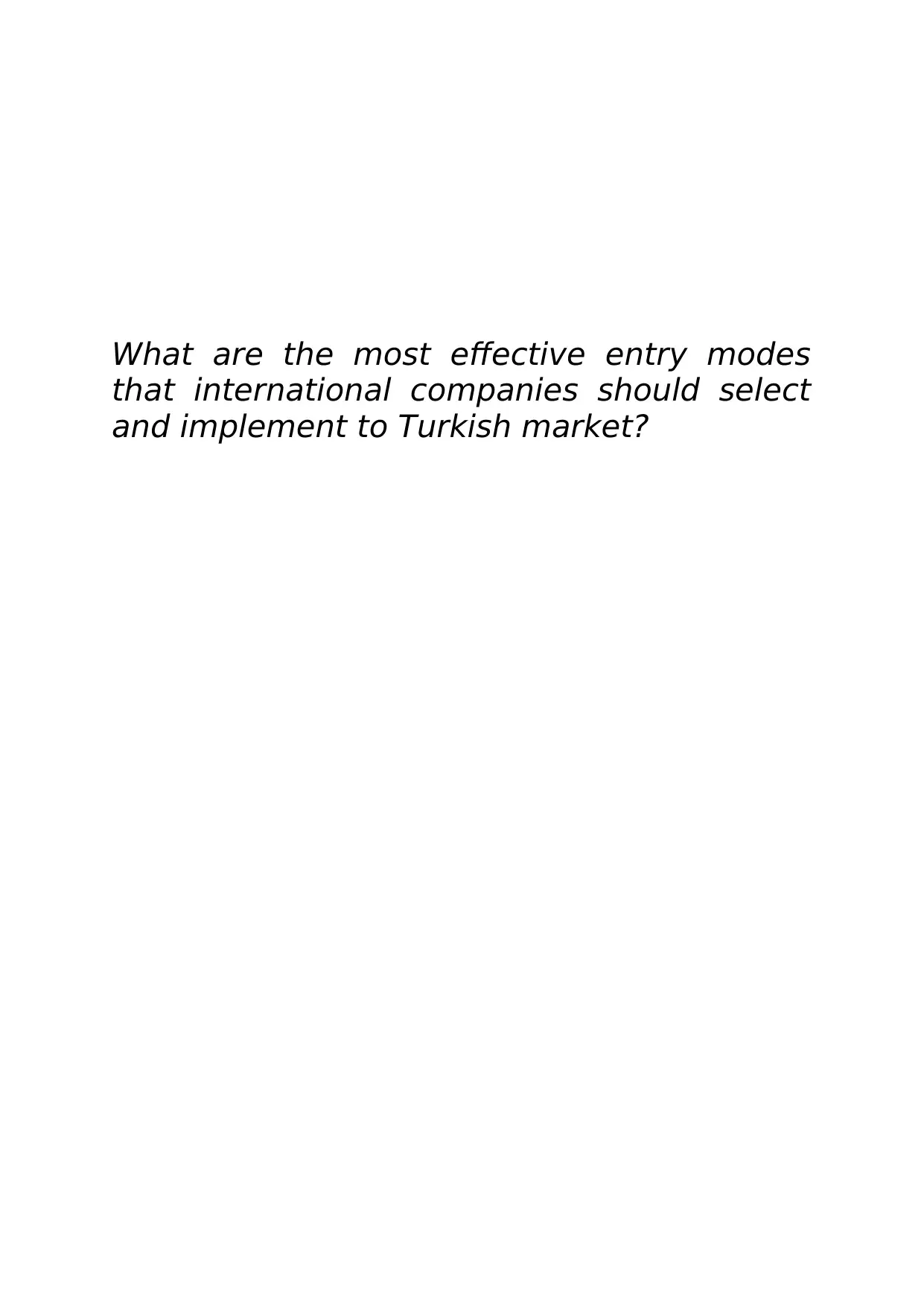
What are the most effective entry modes
that international companies should select
and implement to Turkish market?
that international companies should select
and implement to Turkish market?
Paraphrase This Document
Need a fresh take? Get an instant paraphrase of this document with our AI Paraphraser
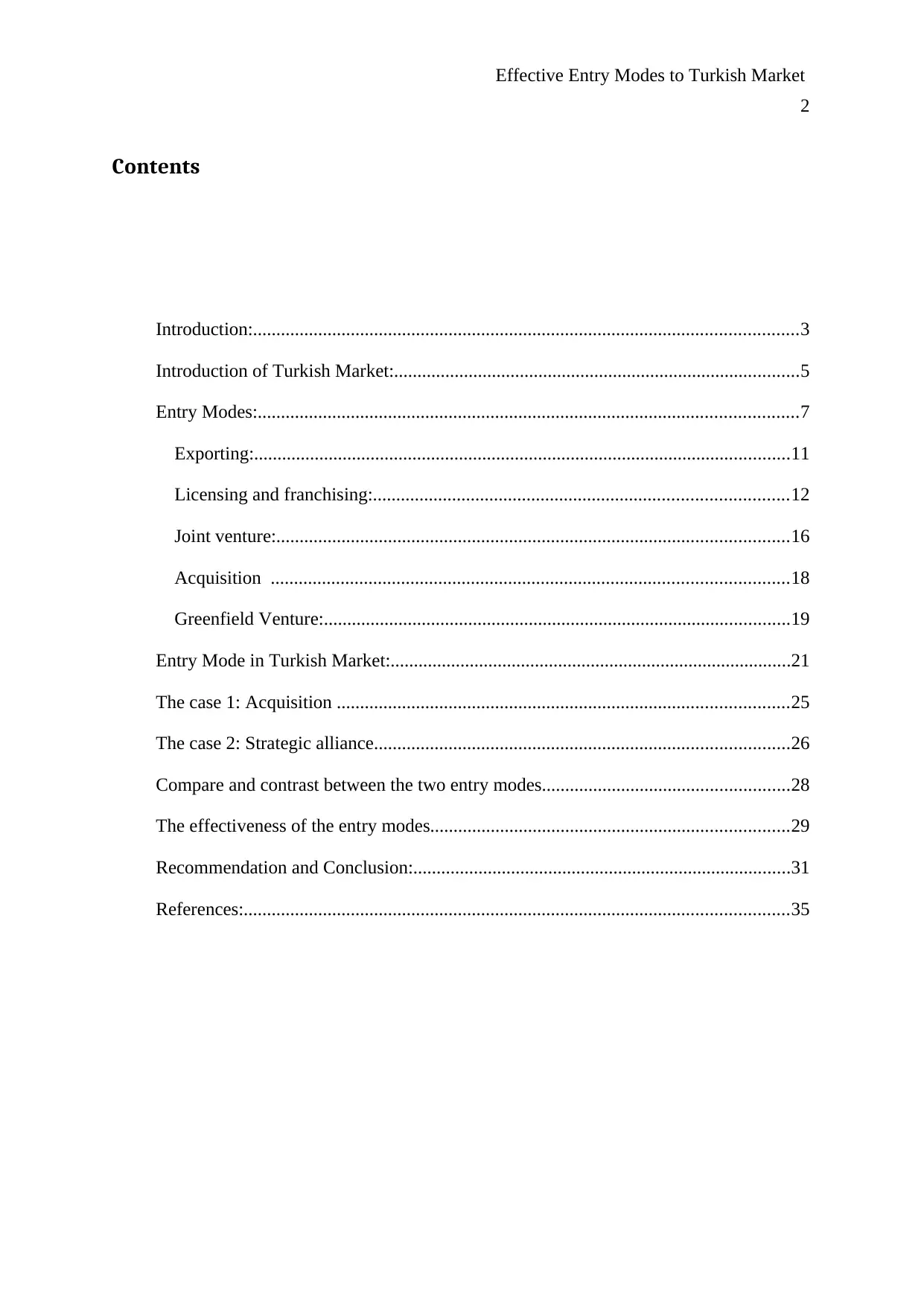
Effective Entry Modes to Turkish Market
2
Contents
Introduction:.....................................................................................................................3
Introduction of Turkish Market:.......................................................................................5
Entry Modes:....................................................................................................................7
Exporting:...................................................................................................................11
Licensing and franchising:.........................................................................................12
Joint venture:..............................................................................................................16
Acquisition ...............................................................................................................18
Greenfield Venture:....................................................................................................19
Entry Mode in Turkish Market:......................................................................................21
The case 1: Acquisition .................................................................................................25
The case 2: Strategic alliance.........................................................................................26
Compare and contrast between the two entry modes.....................................................28
The effectiveness of the entry modes.............................................................................29
Recommendation and Conclusion:.................................................................................31
References:.....................................................................................................................35
2
Contents
Introduction:.....................................................................................................................3
Introduction of Turkish Market:.......................................................................................5
Entry Modes:....................................................................................................................7
Exporting:...................................................................................................................11
Licensing and franchising:.........................................................................................12
Joint venture:..............................................................................................................16
Acquisition ...............................................................................................................18
Greenfield Venture:....................................................................................................19
Entry Mode in Turkish Market:......................................................................................21
The case 1: Acquisition .................................................................................................25
The case 2: Strategic alliance.........................................................................................26
Compare and contrast between the two entry modes.....................................................28
The effectiveness of the entry modes.............................................................................29
Recommendation and Conclusion:.................................................................................31
References:.....................................................................................................................35
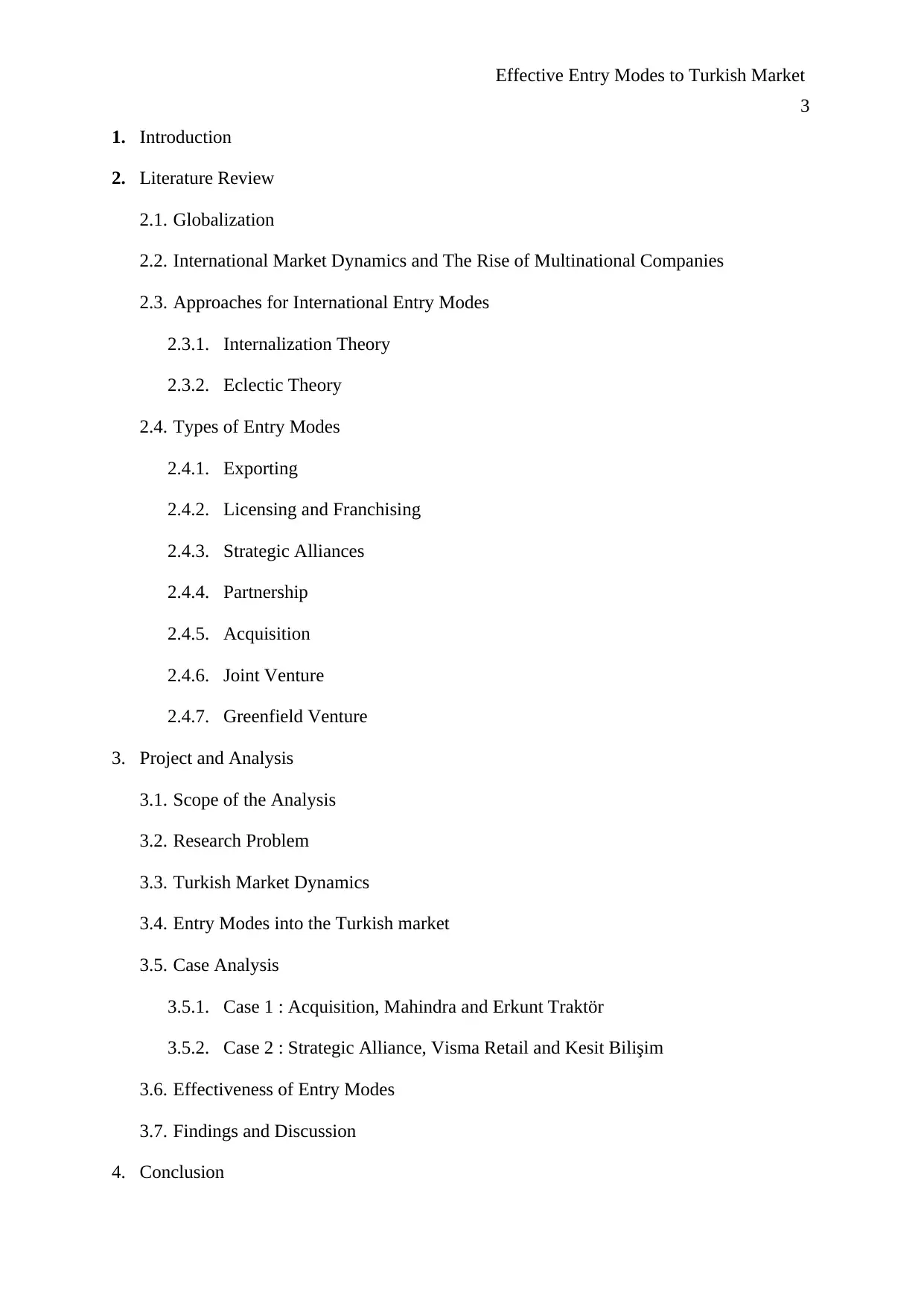
Effective Entry Modes to Turkish Market
3
1. Introduction
2. Literature Review
2.1. Globalization
2.2. International Market Dynamics and The Rise of Multinational Companies
2.3. Approaches for International Entry Modes
2.3.1. Internalization Theory
2.3.2. Eclectic Theory
2.4. Types of Entry Modes
2.4.1. Exporting
2.4.2. Licensing and Franchising
2.4.3. Strategic Alliances
2.4.4. Partnership
2.4.5. Acquisition
2.4.6. Joint Venture
2.4.7. Greenfield Venture
3. Project and Analysis
3.1. Scope of the Analysis
3.2. Research Problem
3.3. Turkish Market Dynamics
3.4. Entry Modes into the Turkish market
3.5. Case Analysis
3.5.1. Case 1 : Acquisition, Mahindra and Erkunt Traktör
3.5.2. Case 2 : Strategic Alliance, Visma Retail and Kesit Bilişim
3.6. Effectiveness of Entry Modes
3.7. Findings and Discussion
4. Conclusion
3
1. Introduction
2. Literature Review
2.1. Globalization
2.2. International Market Dynamics and The Rise of Multinational Companies
2.3. Approaches for International Entry Modes
2.3.1. Internalization Theory
2.3.2. Eclectic Theory
2.4. Types of Entry Modes
2.4.1. Exporting
2.4.2. Licensing and Franchising
2.4.3. Strategic Alliances
2.4.4. Partnership
2.4.5. Acquisition
2.4.6. Joint Venture
2.4.7. Greenfield Venture
3. Project and Analysis
3.1. Scope of the Analysis
3.2. Research Problem
3.3. Turkish Market Dynamics
3.4. Entry Modes into the Turkish market
3.5. Case Analysis
3.5.1. Case 1 : Acquisition, Mahindra and Erkunt Traktör
3.5.2. Case 2 : Strategic Alliance, Visma Retail and Kesit Bilişim
3.6. Effectiveness of Entry Modes
3.7. Findings and Discussion
4. Conclusion
⊘ This is a preview!⊘
Do you want full access?
Subscribe today to unlock all pages.

Trusted by 1+ million students worldwide
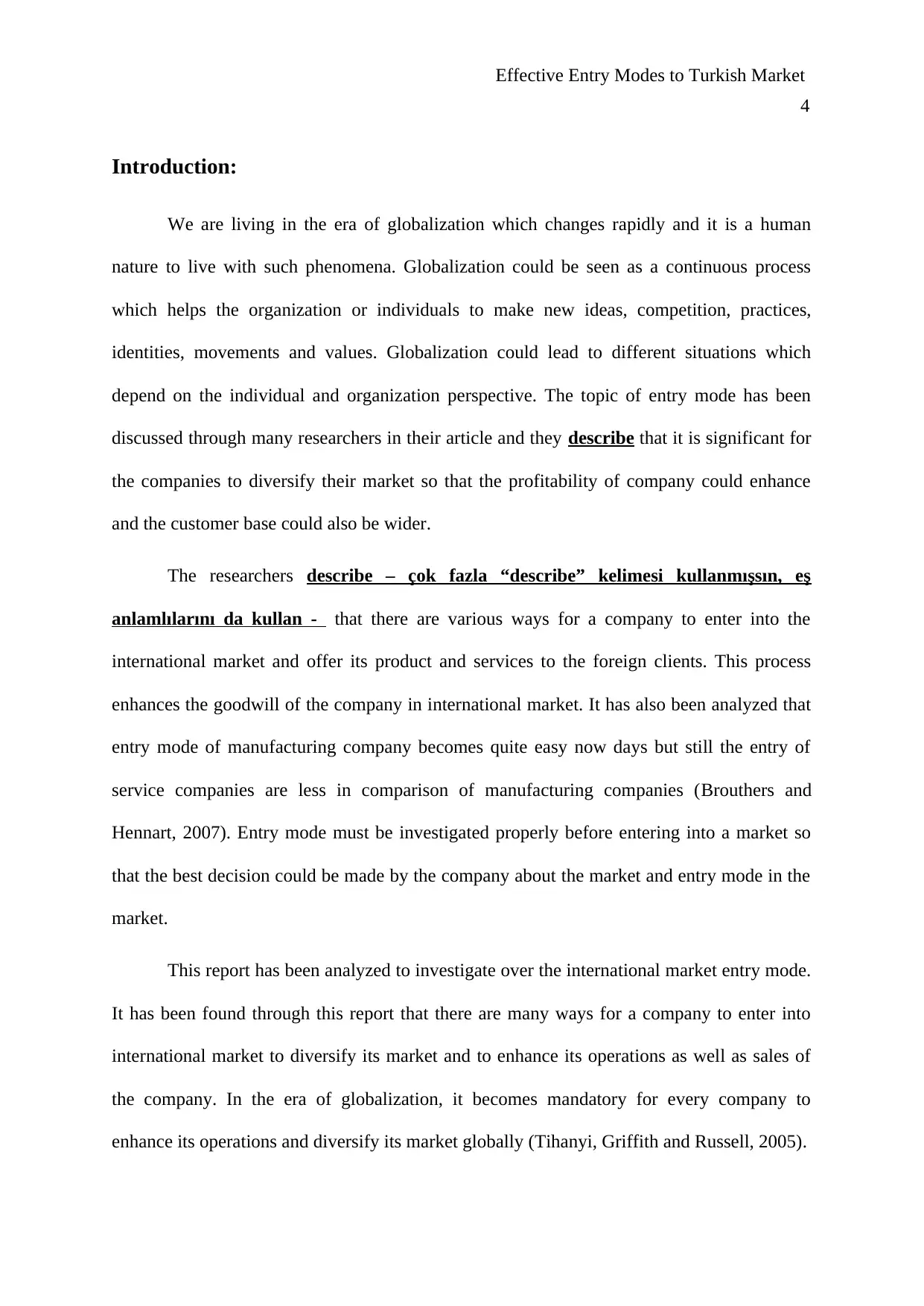
Effective Entry Modes to Turkish Market
4
Introduction:
We are living in the era of globalization which changes rapidly and it is a human
nature to live with such phenomena. Globalization could be seen as a continuous process
which helps the organization or individuals to make new ideas, competition, practices,
identities, movements and values. Globalization could lead to different situations which
depend on the individual and organization perspective. The topic of entry mode has been
discussed through many researchers in their article and they describe that it is significant for
the companies to diversify their market so that the profitability of company could enhance
and the customer base could also be wider.
The researchers describe – çok fazla “describe” kelimesi kullanmışsın, eş
anlamlılarını da kullan - that there are various ways for a company to enter into the
international market and offer its product and services to the foreign clients. This process
enhances the goodwill of the company in international market. It has also been analyzed that
entry mode of manufacturing company becomes quite easy now days but still the entry of
service companies are less in comparison of manufacturing companies (Brouthers and
Hennart, 2007). Entry mode must be investigated properly before entering into a market so
that the best decision could be made by the company about the market and entry mode in the
market.
This report has been analyzed to investigate over the international market entry mode.
It has been found through this report that there are many ways for a company to enter into
international market to diversify its market and to enhance its operations as well as sales of
the company. In the era of globalization, it becomes mandatory for every company to
enhance its operations and diversify its market globally (Tihanyi, Griffith and Russell, 2005).
4
Introduction:
We are living in the era of globalization which changes rapidly and it is a human
nature to live with such phenomena. Globalization could be seen as a continuous process
which helps the organization or individuals to make new ideas, competition, practices,
identities, movements and values. Globalization could lead to different situations which
depend on the individual and organization perspective. The topic of entry mode has been
discussed through many researchers in their article and they describe that it is significant for
the companies to diversify their market so that the profitability of company could enhance
and the customer base could also be wider.
The researchers describe – çok fazla “describe” kelimesi kullanmışsın, eş
anlamlılarını da kullan - that there are various ways for a company to enter into the
international market and offer its product and services to the foreign clients. This process
enhances the goodwill of the company in international market. It has also been analyzed that
entry mode of manufacturing company becomes quite easy now days but still the entry of
service companies are less in comparison of manufacturing companies (Brouthers and
Hennart, 2007). Entry mode must be investigated properly before entering into a market so
that the best decision could be made by the company about the market and entry mode in the
market.
This report has been analyzed to investigate over the international market entry mode.
It has been found through this report that there are many ways for a company to enter into
international market to diversify its market and to enhance its operations as well as sales of
the company. In the era of globalization, it becomes mandatory for every company to
enhance its operations and diversify its market globally (Tihanyi, Griffith and Russell, 2005).
Paraphrase This Document
Need a fresh take? Get an instant paraphrase of this document with our AI Paraphraser
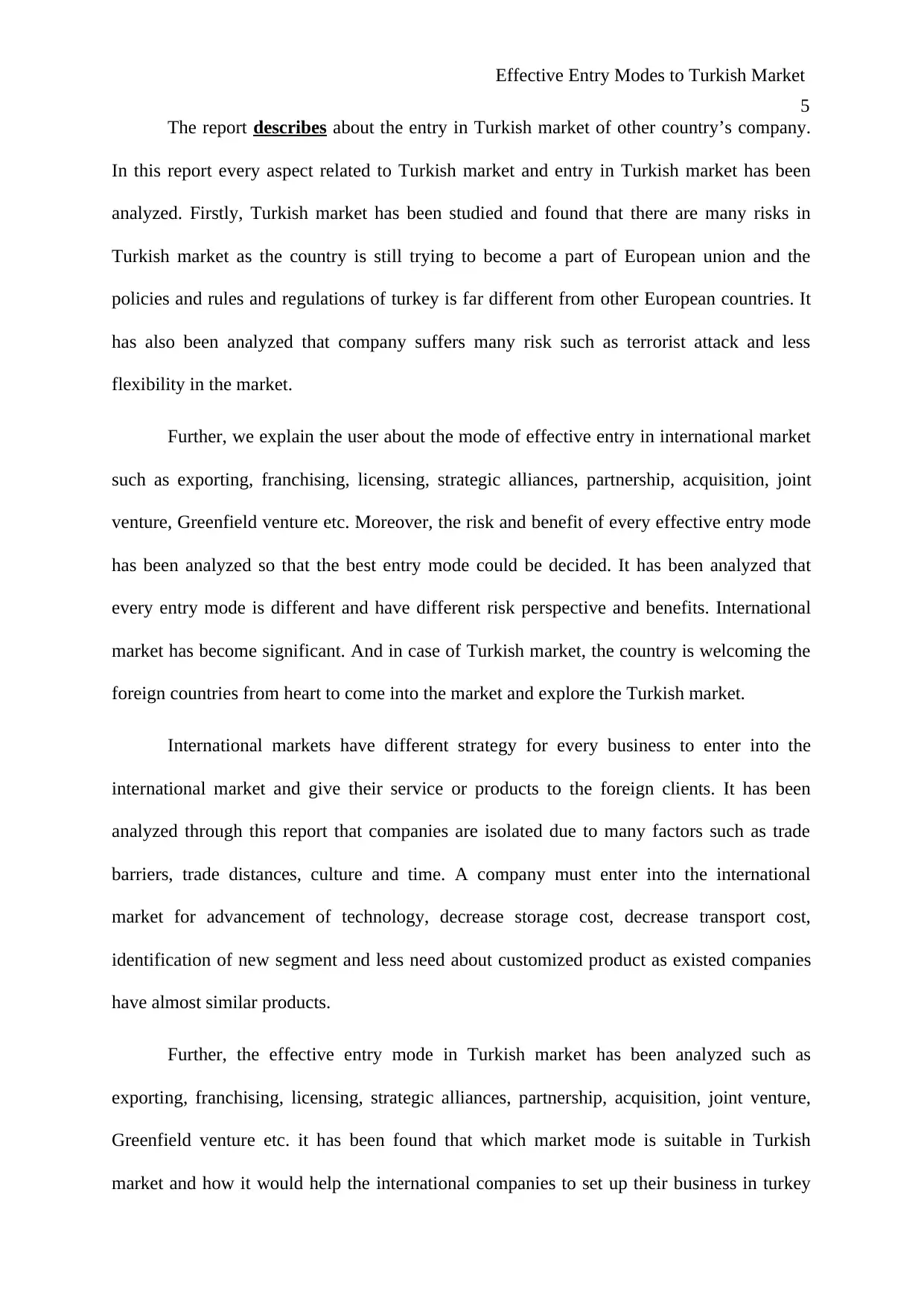
Effective Entry Modes to Turkish Market
5
The report describes about the entry in Turkish market of other country’s company.
In this report every aspect related to Turkish market and entry in Turkish market has been
analyzed. Firstly, Turkish market has been studied and found that there are many risks in
Turkish market as the country is still trying to become a part of European union and the
policies and rules and regulations of turkey is far different from other European countries. It
has also been analyzed that company suffers many risk such as terrorist attack and less
flexibility in the market.
Further, we explain the user about the mode of effective entry in international market
such as exporting, franchising, licensing, strategic alliances, partnership, acquisition, joint
venture, Greenfield venture etc. Moreover, the risk and benefit of every effective entry mode
has been analyzed so that the best entry mode could be decided. It has been analyzed that
every entry mode is different and have different risk perspective and benefits. International
market has become significant. And in case of Turkish market, the country is welcoming the
foreign countries from heart to come into the market and explore the Turkish market.
International markets have different strategy for every business to enter into the
international market and give their service or products to the foreign clients. It has been
analyzed through this report that companies are isolated due to many factors such as trade
barriers, trade distances, culture and time. A company must enter into the international
market for advancement of technology, decrease storage cost, decrease transport cost,
identification of new segment and less need about customized product as existed companies
have almost similar products.
Further, the effective entry mode in Turkish market has been analyzed such as
exporting, franchising, licensing, strategic alliances, partnership, acquisition, joint venture,
Greenfield venture etc. it has been found that which market mode is suitable in Turkish
market and how it would help the international companies to set up their business in turkey
5
The report describes about the entry in Turkish market of other country’s company.
In this report every aspect related to Turkish market and entry in Turkish market has been
analyzed. Firstly, Turkish market has been studied and found that there are many risks in
Turkish market as the country is still trying to become a part of European union and the
policies and rules and regulations of turkey is far different from other European countries. It
has also been analyzed that company suffers many risk such as terrorist attack and less
flexibility in the market.
Further, we explain the user about the mode of effective entry in international market
such as exporting, franchising, licensing, strategic alliances, partnership, acquisition, joint
venture, Greenfield venture etc. Moreover, the risk and benefit of every effective entry mode
has been analyzed so that the best entry mode could be decided. It has been analyzed that
every entry mode is different and have different risk perspective and benefits. International
market has become significant. And in case of Turkish market, the country is welcoming the
foreign countries from heart to come into the market and explore the Turkish market.
International markets have different strategy for every business to enter into the
international market and give their service or products to the foreign clients. It has been
analyzed through this report that companies are isolated due to many factors such as trade
barriers, trade distances, culture and time. A company must enter into the international
market for advancement of technology, decrease storage cost, decrease transport cost,
identification of new segment and less need about customized product as existed companies
have almost similar products.
Further, the effective entry mode in Turkish market has been analyzed such as
exporting, franchising, licensing, strategic alliances, partnership, acquisition, joint venture,
Greenfield venture etc. it has been found that which market mode is suitable in Turkish
market and how it would help the international companies to set up their business in turkey
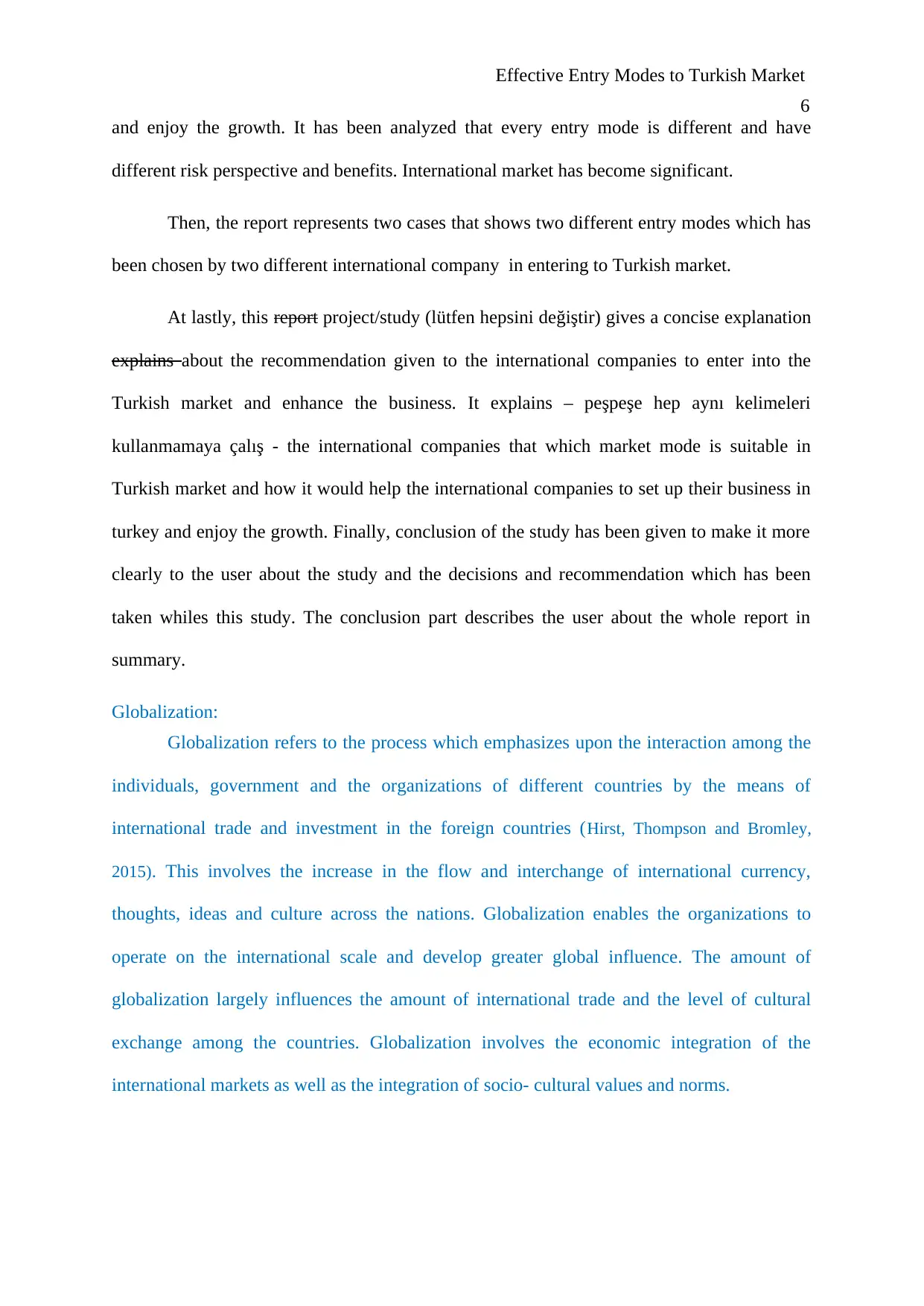
Effective Entry Modes to Turkish Market
6
and enjoy the growth. It has been analyzed that every entry mode is different and have
different risk perspective and benefits. International market has become significant.
Then, the report represents two cases that shows two different entry modes which has
been chosen by two different international company in entering to Turkish market.
At lastly, this report project/study (lütfen hepsini değiştir) gives a concise explanation
explains about the recommendation given to the international companies to enter into the
Turkish market and enhance the business. It explains – peşpeşe hep aynı kelimeleri
kullanmamaya çalış - the international companies that which market mode is suitable in
Turkish market and how it would help the international companies to set up their business in
turkey and enjoy the growth. Finally, conclusion of the study has been given to make it more
clearly to the user about the study and the decisions and recommendation which has been
taken whiles this study. The conclusion part describes the user about the whole report in
summary.
Globalization:
Globalization refers to the process which emphasizes upon the interaction among the
individuals, government and the organizations of different countries by the means of
international trade and investment in the foreign countries (Hirst, Thompson and Bromley,
2015). This involves the increase in the flow and interchange of international currency,
thoughts, ideas and culture across the nations. Globalization enables the organizations to
operate on the international scale and develop greater global influence. The amount of
globalization largely influences the amount of international trade and the level of cultural
exchange among the countries. Globalization involves the economic integration of the
international markets as well as the integration of socio- cultural values and norms.
6
and enjoy the growth. It has been analyzed that every entry mode is different and have
different risk perspective and benefits. International market has become significant.
Then, the report represents two cases that shows two different entry modes which has
been chosen by two different international company in entering to Turkish market.
At lastly, this report project/study (lütfen hepsini değiştir) gives a concise explanation
explains about the recommendation given to the international companies to enter into the
Turkish market and enhance the business. It explains – peşpeşe hep aynı kelimeleri
kullanmamaya çalış - the international companies that which market mode is suitable in
Turkish market and how it would help the international companies to set up their business in
turkey and enjoy the growth. Finally, conclusion of the study has been given to make it more
clearly to the user about the study and the decisions and recommendation which has been
taken whiles this study. The conclusion part describes the user about the whole report in
summary.
Globalization:
Globalization refers to the process which emphasizes upon the interaction among the
individuals, government and the organizations of different countries by the means of
international trade and investment in the foreign countries (Hirst, Thompson and Bromley,
2015). This involves the increase in the flow and interchange of international currency,
thoughts, ideas and culture across the nations. Globalization enables the organizations to
operate on the international scale and develop greater global influence. The amount of
globalization largely influences the amount of international trade and the level of cultural
exchange among the countries. Globalization involves the economic integration of the
international markets as well as the integration of socio- cultural values and norms.
⊘ This is a preview!⊘
Do you want full access?
Subscribe today to unlock all pages.

Trusted by 1+ million students worldwide
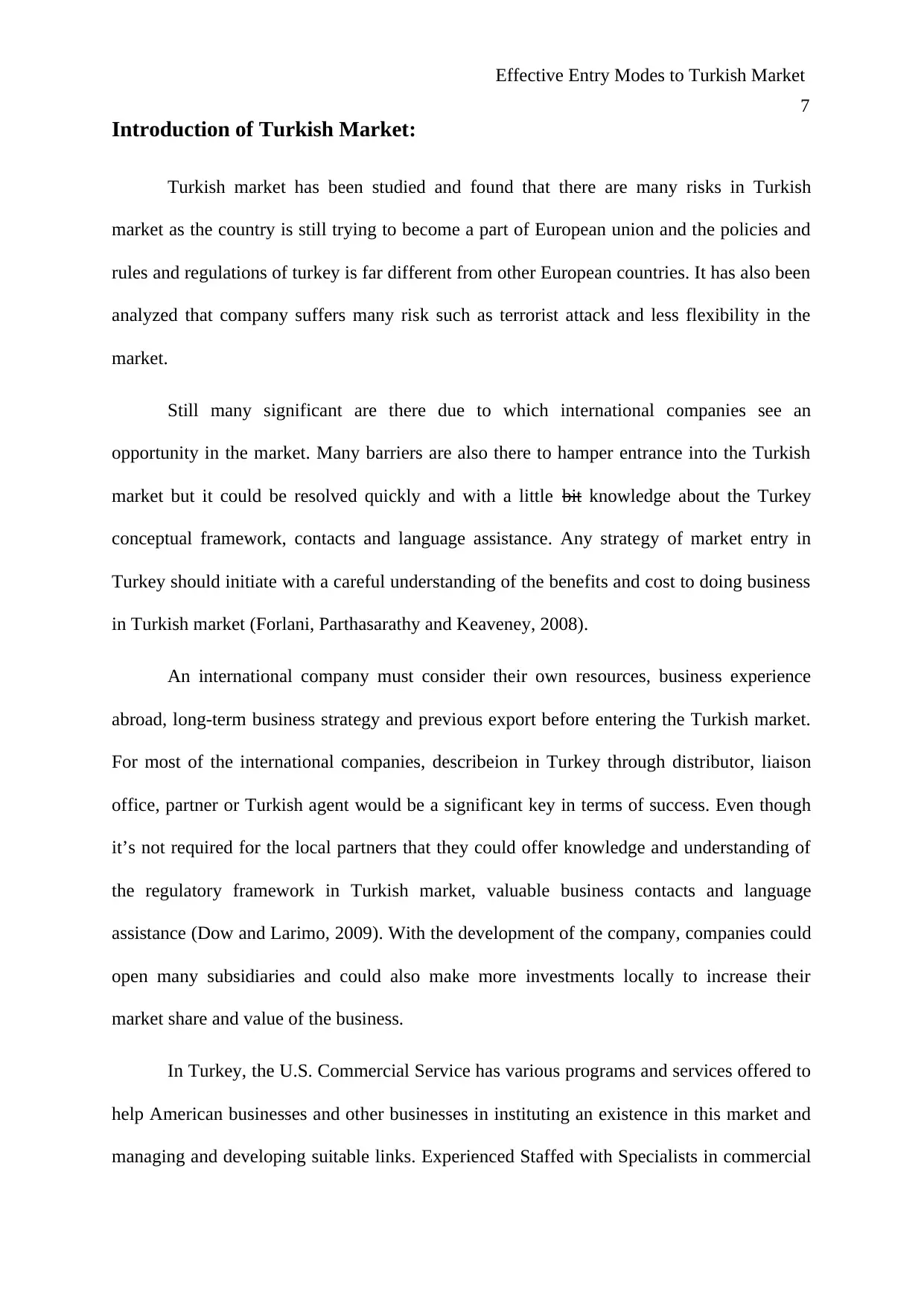
Effective Entry Modes to Turkish Market
7
Introduction of Turkish Market:
Turkish market has been studied and found that there are many risks in Turkish
market as the country is still trying to become a part of European union and the policies and
rules and regulations of turkey is far different from other European countries. It has also been
analyzed that company suffers many risk such as terrorist attack and less flexibility in the
market.
Still many significant are there due to which international companies see an
opportunity in the market. Many barriers are also there to hamper entrance into the Turkish
market but it could be resolved quickly and with a little bit knowledge about the Turkey
conceptual framework, contacts and language assistance. Any strategy of market entry in
Turkey should initiate with a careful understanding of the benefits and cost to doing business
in Turkish market (Forlani, Parthasarathy and Keaveney, 2008).
An international company must consider their own resources, business experience
abroad, long-term business strategy and previous export before entering the Turkish market.
For most of the international companies, describeion in Turkey through distributor, liaison
office, partner or Turkish agent would be a significant key in terms of success. Even though
it’s not required for the local partners that they could offer knowledge and understanding of
the regulatory framework in Turkish market, valuable business contacts and language
assistance (Dow and Larimo, 2009). With the development of the company, companies could
open many subsidiaries and could also make more investments locally to increase their
market share and value of the business.
In Turkey, the U.S. Commercial Service has various programs and services offered to
help American businesses and other businesses in instituting an existence in this market and
managing and developing suitable links. Experienced Staffed with Specialists in commercial
7
Introduction of Turkish Market:
Turkish market has been studied and found that there are many risks in Turkish
market as the country is still trying to become a part of European union and the policies and
rules and regulations of turkey is far different from other European countries. It has also been
analyzed that company suffers many risk such as terrorist attack and less flexibility in the
market.
Still many significant are there due to which international companies see an
opportunity in the market. Many barriers are also there to hamper entrance into the Turkish
market but it could be resolved quickly and with a little bit knowledge about the Turkey
conceptual framework, contacts and language assistance. Any strategy of market entry in
Turkey should initiate with a careful understanding of the benefits and cost to doing business
in Turkish market (Forlani, Parthasarathy and Keaveney, 2008).
An international company must consider their own resources, business experience
abroad, long-term business strategy and previous export before entering the Turkish market.
For most of the international companies, describeion in Turkey through distributor, liaison
office, partner or Turkish agent would be a significant key in terms of success. Even though
it’s not required for the local partners that they could offer knowledge and understanding of
the regulatory framework in Turkish market, valuable business contacts and language
assistance (Dow and Larimo, 2009). With the development of the company, companies could
open many subsidiaries and could also make more investments locally to increase their
market share and value of the business.
In Turkey, the U.S. Commercial Service has various programs and services offered to
help American businesses and other businesses in instituting an existence in this market and
managing and developing suitable links. Experienced Staffed with Specialists in commercial
Paraphrase This Document
Need a fresh take? Get an instant paraphrase of this document with our AI Paraphraser
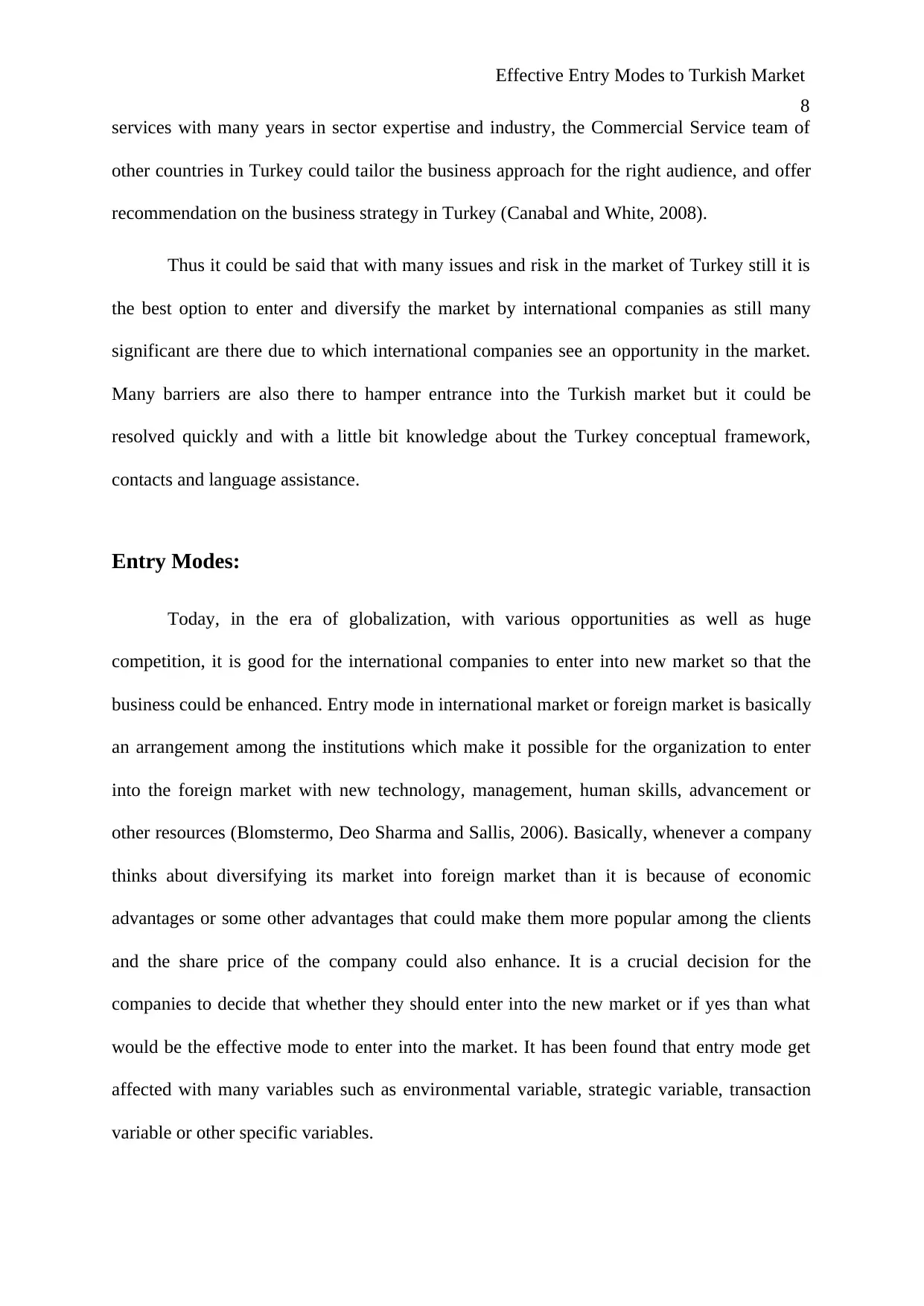
Effective Entry Modes to Turkish Market
8
services with many years in sector expertise and industry, the Commercial Service team of
other countries in Turkey could tailor the business approach for the right audience, and offer
recommendation on the business strategy in Turkey (Canabal and White, 2008).
Thus it could be said that with many issues and risk in the market of Turkey still it is
the best option to enter and diversify the market by international companies as still many
significant are there due to which international companies see an opportunity in the market.
Many barriers are also there to hamper entrance into the Turkish market but it could be
resolved quickly and with a little bit knowledge about the Turkey conceptual framework,
contacts and language assistance.
Entry Modes:
Today, in the era of globalization, with various opportunities as well as huge
competition, it is good for the international companies to enter into new market so that the
business could be enhanced. Entry mode in international market or foreign market is basically
an arrangement among the institutions which make it possible for the organization to enter
into the foreign market with new technology, management, human skills, advancement or
other resources (Blomstermo, Deo Sharma and Sallis, 2006). Basically, whenever a company
thinks about diversifying its market into foreign market than it is because of economic
advantages or some other advantages that could make them more popular among the clients
and the share price of the company could also enhance. It is a crucial decision for the
companies to decide that whether they should enter into the new market or if yes than what
would be the effective mode to enter into the market. It has been found that entry mode get
affected with many variables such as environmental variable, strategic variable, transaction
variable or other specific variables.
8
services with many years in sector expertise and industry, the Commercial Service team of
other countries in Turkey could tailor the business approach for the right audience, and offer
recommendation on the business strategy in Turkey (Canabal and White, 2008).
Thus it could be said that with many issues and risk in the market of Turkey still it is
the best option to enter and diversify the market by international companies as still many
significant are there due to which international companies see an opportunity in the market.
Many barriers are also there to hamper entrance into the Turkish market but it could be
resolved quickly and with a little bit knowledge about the Turkey conceptual framework,
contacts and language assistance.
Entry Modes:
Today, in the era of globalization, with various opportunities as well as huge
competition, it is good for the international companies to enter into new market so that the
business could be enhanced. Entry mode in international market or foreign market is basically
an arrangement among the institutions which make it possible for the organization to enter
into the foreign market with new technology, management, human skills, advancement or
other resources (Blomstermo, Deo Sharma and Sallis, 2006). Basically, whenever a company
thinks about diversifying its market into foreign market than it is because of economic
advantages or some other advantages that could make them more popular among the clients
and the share price of the company could also enhance. It is a crucial decision for the
companies to decide that whether they should enter into the new market or if yes than what
would be the effective mode to enter into the market. It has been found that entry mode get
affected with many variables such as environmental variable, strategic variable, transaction
variable or other specific variables.
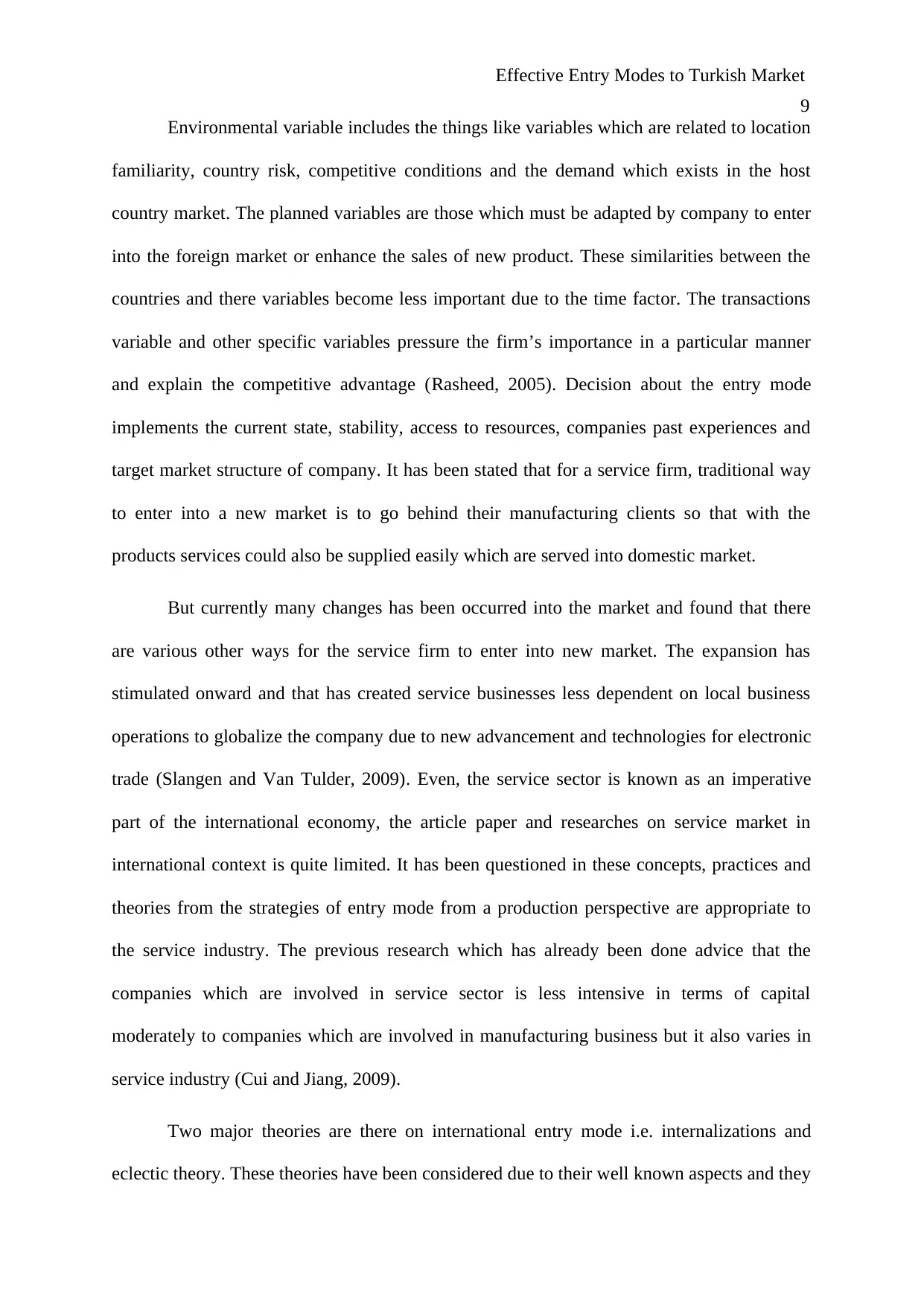
Effective Entry Modes to Turkish Market
9
Environmental variable includes the things like variables which are related to location
familiarity, country risk, competitive conditions and the demand which exists in the host
country market. The planned variables are those which must be adapted by company to enter
into the foreign market or enhance the sales of new product. These similarities between the
countries and there variables become less important due to the time factor. The transactions
variable and other specific variables pressure the firm’s importance in a particular manner
and explain the competitive advantage (Rasheed, 2005). Decision about the entry mode
implements the current state, stability, access to resources, companies past experiences and
target market structure of company. It has been stated that for a service firm, traditional way
to enter into a new market is to go behind their manufacturing clients so that with the
products services could also be supplied easily which are served into domestic market.
But currently many changes has been occurred into the market and found that there
are various other ways for the service firm to enter into new market. The expansion has
stimulated onward and that has created service businesses less dependent on local business
operations to globalize the company due to new advancement and technologies for electronic
trade (Slangen and Van Tulder, 2009). Even, the service sector is known as an imperative
part of the international economy, the article paper and researches on service market in
international context is quite limited. It has been questioned in these concepts, practices and
theories from the strategies of entry mode from a production perspective are appropriate to
the service industry. The previous research which has already been done advice that the
companies which are involved in service sector is less intensive in terms of capital
moderately to companies which are involved in manufacturing business but it also varies in
service industry (Cui and Jiang, 2009).
Two major theories are there on international entry mode i.e. internalizations and
eclectic theory. These theories have been considered due to their well known aspects and they
9
Environmental variable includes the things like variables which are related to location
familiarity, country risk, competitive conditions and the demand which exists in the host
country market. The planned variables are those which must be adapted by company to enter
into the foreign market or enhance the sales of new product. These similarities between the
countries and there variables become less important due to the time factor. The transactions
variable and other specific variables pressure the firm’s importance in a particular manner
and explain the competitive advantage (Rasheed, 2005). Decision about the entry mode
implements the current state, stability, access to resources, companies past experiences and
target market structure of company. It has been stated that for a service firm, traditional way
to enter into a new market is to go behind their manufacturing clients so that with the
products services could also be supplied easily which are served into domestic market.
But currently many changes has been occurred into the market and found that there
are various other ways for the service firm to enter into new market. The expansion has
stimulated onward and that has created service businesses less dependent on local business
operations to globalize the company due to new advancement and technologies for electronic
trade (Slangen and Van Tulder, 2009). Even, the service sector is known as an imperative
part of the international economy, the article paper and researches on service market in
international context is quite limited. It has been questioned in these concepts, practices and
theories from the strategies of entry mode from a production perspective are appropriate to
the service industry. The previous research which has already been done advice that the
companies which are involved in service sector is less intensive in terms of capital
moderately to companies which are involved in manufacturing business but it also varies in
service industry (Cui and Jiang, 2009).
Two major theories are there on international entry mode i.e. internalizations and
eclectic theory. These theories have been considered due to their well known aspects and they
⊘ This is a preview!⊘
Do you want full access?
Subscribe today to unlock all pages.

Trusted by 1+ million students worldwide
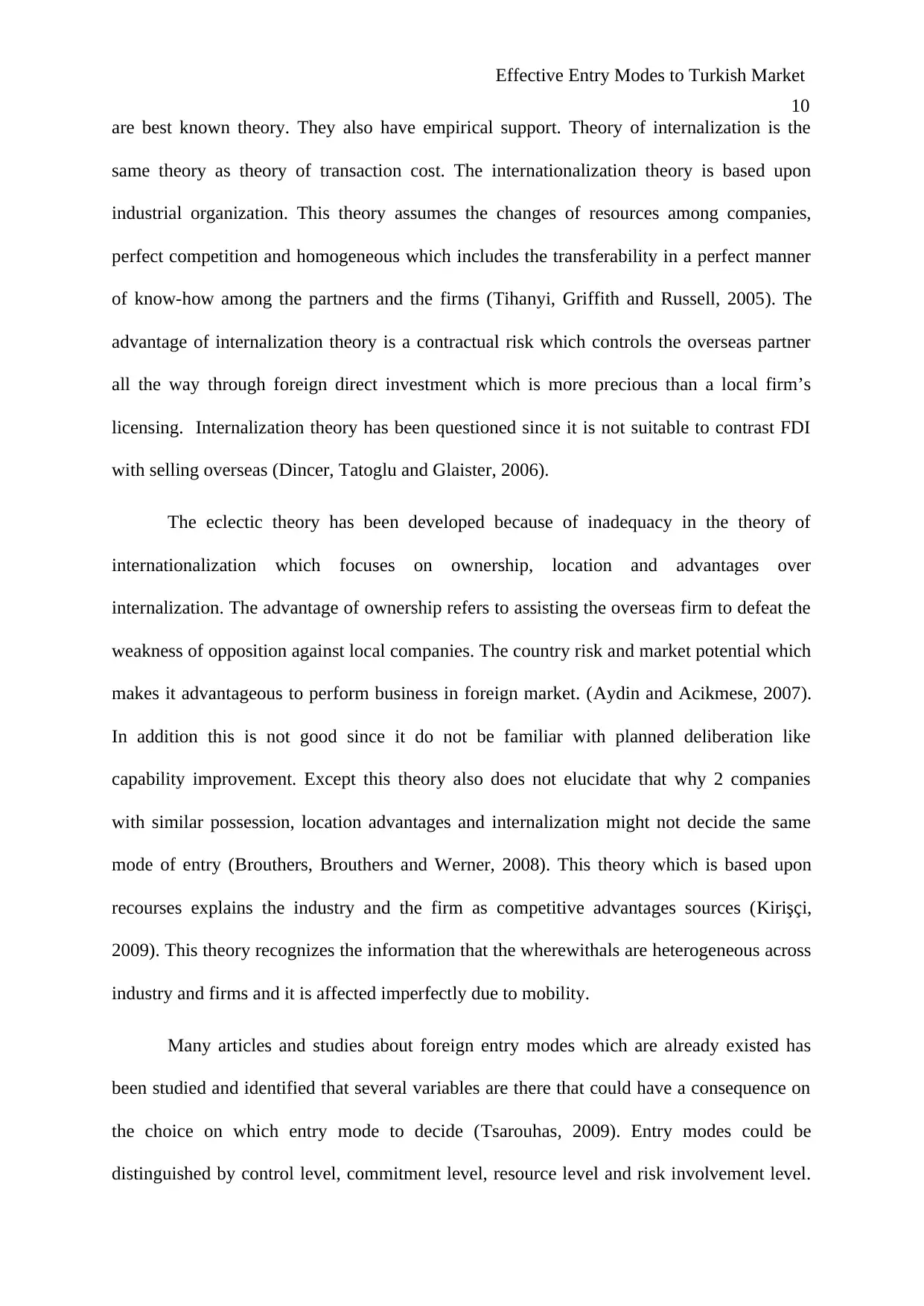
Effective Entry Modes to Turkish Market
10
are best known theory. They also have empirical support. Theory of internalization is the
same theory as theory of transaction cost. The internationalization theory is based upon
industrial organization. This theory assumes the changes of resources among companies,
perfect competition and homogeneous which includes the transferability in a perfect manner
of know-how among the partners and the firms (Tihanyi, Griffith and Russell, 2005). The
advantage of internalization theory is a contractual risk which controls the overseas partner
all the way through foreign direct investment which is more precious than a local firm’s
licensing. Internalization theory has been questioned since it is not suitable to contrast FDI
with selling overseas (Dincer, Tatoglu and Glaister, 2006).
The eclectic theory has been developed because of inadequacy in the theory of
internationalization which focuses on ownership, location and advantages over
internalization. The advantage of ownership refers to assisting the overseas firm to defeat the
weakness of opposition against local companies. The country risk and market potential which
makes it advantageous to perform business in foreign market. (Aydin and Acikmese, 2007).
In addition this is not good since it do not be familiar with planned deliberation like
capability improvement. Except this theory also does not elucidate that why 2 companies
with similar possession, location advantages and internalization might not decide the same
mode of entry (Brouthers, Brouthers and Werner, 2008). This theory which is based upon
recourses explains the industry and the firm as competitive advantages sources (Kirişçi,
2009). This theory recognizes the information that the wherewithals are heterogeneous across
industry and firms and it is affected imperfectly due to mobility.
Many articles and studies about foreign entry modes which are already existed has
been studied and identified that several variables are there that could have a consequence on
the choice on which entry mode to decide (Tsarouhas, 2009). Entry modes could be
distinguished by control level, commitment level, resource level and risk involvement level.
10
are best known theory. They also have empirical support. Theory of internalization is the
same theory as theory of transaction cost. The internationalization theory is based upon
industrial organization. This theory assumes the changes of resources among companies,
perfect competition and homogeneous which includes the transferability in a perfect manner
of know-how among the partners and the firms (Tihanyi, Griffith and Russell, 2005). The
advantage of internalization theory is a contractual risk which controls the overseas partner
all the way through foreign direct investment which is more precious than a local firm’s
licensing. Internalization theory has been questioned since it is not suitable to contrast FDI
with selling overseas (Dincer, Tatoglu and Glaister, 2006).
The eclectic theory has been developed because of inadequacy in the theory of
internationalization which focuses on ownership, location and advantages over
internalization. The advantage of ownership refers to assisting the overseas firm to defeat the
weakness of opposition against local companies. The country risk and market potential which
makes it advantageous to perform business in foreign market. (Aydin and Acikmese, 2007).
In addition this is not good since it do not be familiar with planned deliberation like
capability improvement. Except this theory also does not elucidate that why 2 companies
with similar possession, location advantages and internalization might not decide the same
mode of entry (Brouthers, Brouthers and Werner, 2008). This theory which is based upon
recourses explains the industry and the firm as competitive advantages sources (Kirişçi,
2009). This theory recognizes the information that the wherewithals are heterogeneous across
industry and firms and it is affected imperfectly due to mobility.
Many articles and studies about foreign entry modes which are already existed has
been studied and identified that several variables are there that could have a consequence on
the choice on which entry mode to decide (Tsarouhas, 2009). Entry modes could be
distinguished by control level, commitment level, resource level and risk involvement level.
Paraphrase This Document
Need a fresh take? Get an instant paraphrase of this document with our AI Paraphraser
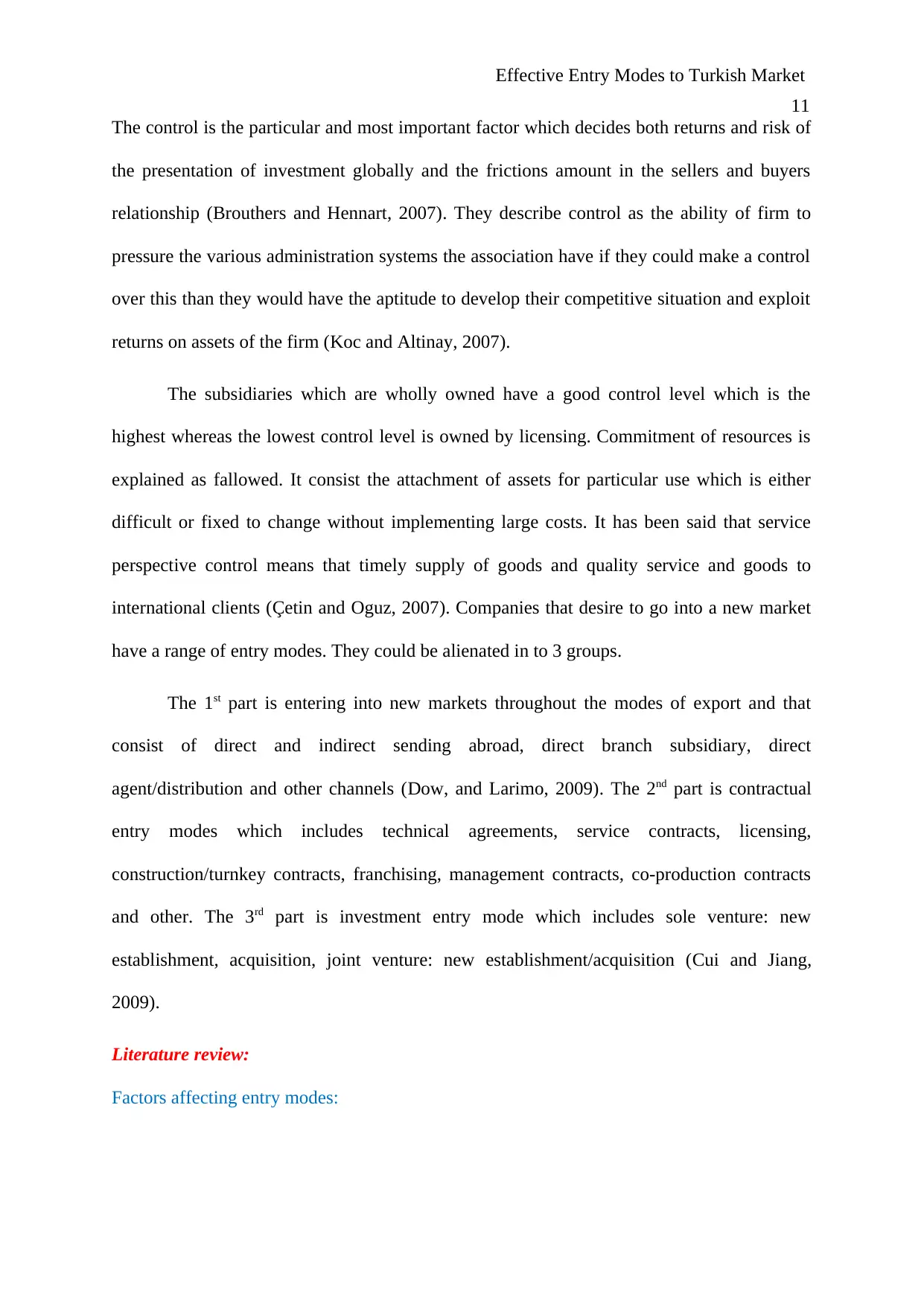
Effective Entry Modes to Turkish Market
11
The control is the particular and most important factor which decides both returns and risk of
the presentation of investment globally and the frictions amount in the sellers and buyers
relationship (Brouthers and Hennart, 2007). They describe control as the ability of firm to
pressure the various administration systems the association have if they could make a control
over this than they would have the aptitude to develop their competitive situation and exploit
returns on assets of the firm (Koc and Altinay, 2007).
The subsidiaries which are wholly owned have a good control level which is the
highest whereas the lowest control level is owned by licensing. Commitment of resources is
explained as fallowed. It consist the attachment of assets for particular use which is either
difficult or fixed to change without implementing large costs. It has been said that service
perspective control means that timely supply of goods and quality service and goods to
international clients (Çetin and Oguz, 2007). Companies that desire to go into a new market
have a range of entry modes. They could be alienated in to 3 groups.
The 1st part is entering into new markets throughout the modes of export and that
consist of direct and indirect sending abroad, direct branch subsidiary, direct
agent/distribution and other channels (Dow, and Larimo, 2009). The 2nd part is contractual
entry modes which includes technical agreements, service contracts, licensing,
construction/turnkey contracts, franchising, management contracts, co-production contracts
and other. The 3rd part is investment entry mode which includes sole venture: new
establishment, acquisition, joint venture: new establishment/acquisition (Cui and Jiang,
2009).
Literature review:
Factors affecting entry modes:
11
The control is the particular and most important factor which decides both returns and risk of
the presentation of investment globally and the frictions amount in the sellers and buyers
relationship (Brouthers and Hennart, 2007). They describe control as the ability of firm to
pressure the various administration systems the association have if they could make a control
over this than they would have the aptitude to develop their competitive situation and exploit
returns on assets of the firm (Koc and Altinay, 2007).
The subsidiaries which are wholly owned have a good control level which is the
highest whereas the lowest control level is owned by licensing. Commitment of resources is
explained as fallowed. It consist the attachment of assets for particular use which is either
difficult or fixed to change without implementing large costs. It has been said that service
perspective control means that timely supply of goods and quality service and goods to
international clients (Çetin and Oguz, 2007). Companies that desire to go into a new market
have a range of entry modes. They could be alienated in to 3 groups.
The 1st part is entering into new markets throughout the modes of export and that
consist of direct and indirect sending abroad, direct branch subsidiary, direct
agent/distribution and other channels (Dow, and Larimo, 2009). The 2nd part is contractual
entry modes which includes technical agreements, service contracts, licensing,
construction/turnkey contracts, franchising, management contracts, co-production contracts
and other. The 3rd part is investment entry mode which includes sole venture: new
establishment, acquisition, joint venture: new establishment/acquisition (Cui and Jiang,
2009).
Literature review:
Factors affecting entry modes:
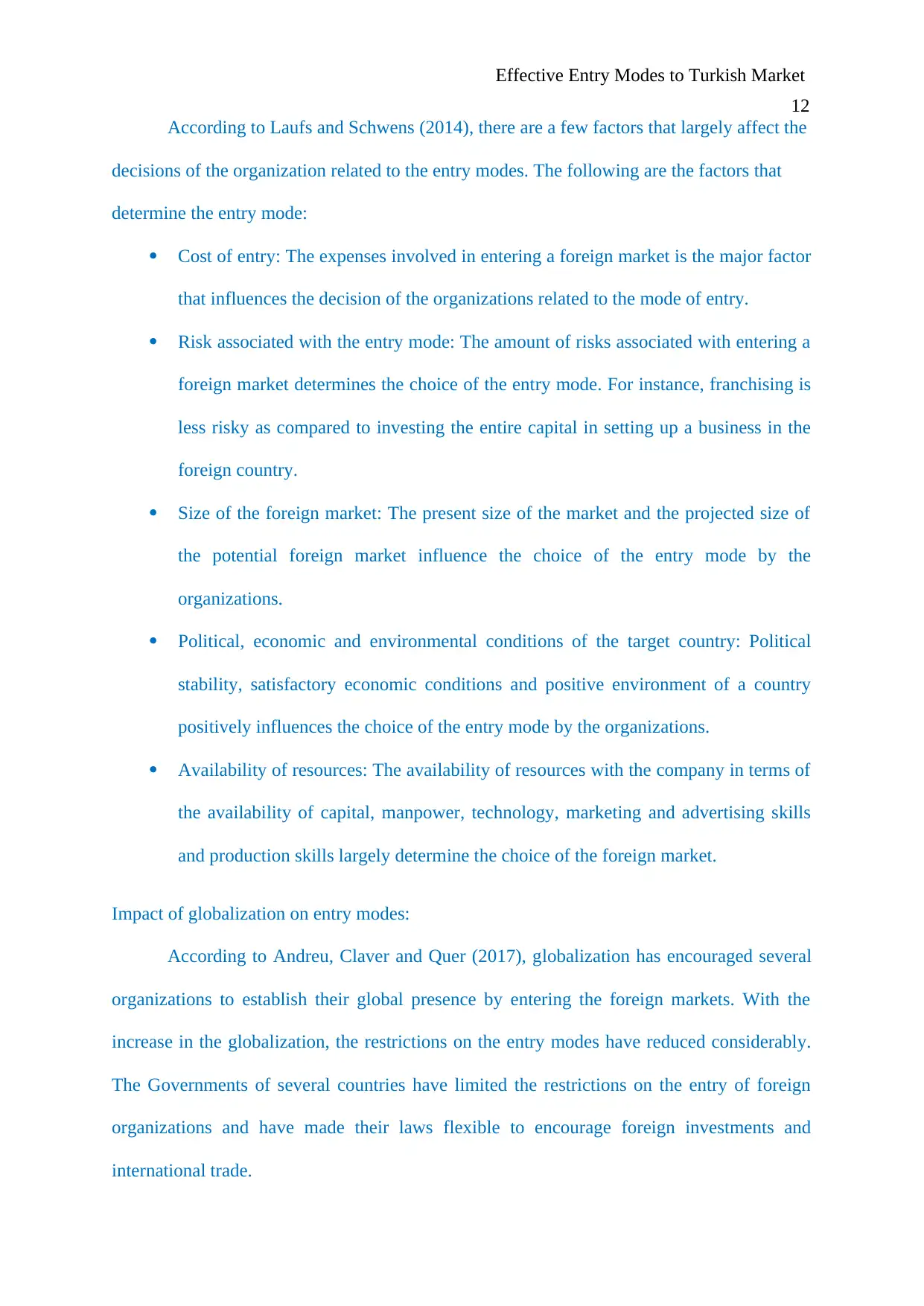
Effective Entry Modes to Turkish Market
12
According to Laufs and Schwens (2014), there are a few factors that largely affect the
decisions of the organization related to the entry modes. The following are the factors that
determine the entry mode:
Cost of entry: The expenses involved in entering a foreign market is the major factor
that influences the decision of the organizations related to the mode of entry.
Risk associated with the entry mode: The amount of risks associated with entering a
foreign market determines the choice of the entry mode. For instance, franchising is
less risky as compared to investing the entire capital in setting up a business in the
foreign country.
Size of the foreign market: The present size of the market and the projected size of
the potential foreign market influence the choice of the entry mode by the
organizations.
Political, economic and environmental conditions of the target country: Political
stability, satisfactory economic conditions and positive environment of a country
positively influences the choice of the entry mode by the organizations.
Availability of resources: The availability of resources with the company in terms of
the availability of capital, manpower, technology, marketing and advertising skills
and production skills largely determine the choice of the foreign market.
Impact of globalization on entry modes:
According to Andreu, Claver and Quer (2017), globalization has encouraged several
organizations to establish their global presence by entering the foreign markets. With the
increase in the globalization, the restrictions on the entry modes have reduced considerably.
The Governments of several countries have limited the restrictions on the entry of foreign
organizations and have made their laws flexible to encourage foreign investments and
international trade.
12
According to Laufs and Schwens (2014), there are a few factors that largely affect the
decisions of the organization related to the entry modes. The following are the factors that
determine the entry mode:
Cost of entry: The expenses involved in entering a foreign market is the major factor
that influences the decision of the organizations related to the mode of entry.
Risk associated with the entry mode: The amount of risks associated with entering a
foreign market determines the choice of the entry mode. For instance, franchising is
less risky as compared to investing the entire capital in setting up a business in the
foreign country.
Size of the foreign market: The present size of the market and the projected size of
the potential foreign market influence the choice of the entry mode by the
organizations.
Political, economic and environmental conditions of the target country: Political
stability, satisfactory economic conditions and positive environment of a country
positively influences the choice of the entry mode by the organizations.
Availability of resources: The availability of resources with the company in terms of
the availability of capital, manpower, technology, marketing and advertising skills
and production skills largely determine the choice of the foreign market.
Impact of globalization on entry modes:
According to Andreu, Claver and Quer (2017), globalization has encouraged several
organizations to establish their global presence by entering the foreign markets. With the
increase in the globalization, the restrictions on the entry modes have reduced considerably.
The Governments of several countries have limited the restrictions on the entry of foreign
organizations and have made their laws flexible to encourage foreign investments and
international trade.
⊘ This is a preview!⊘
Do you want full access?
Subscribe today to unlock all pages.

Trusted by 1+ million students worldwide
1 out of 45
Related Documents
Your All-in-One AI-Powered Toolkit for Academic Success.
+13062052269
info@desklib.com
Available 24*7 on WhatsApp / Email
![[object Object]](/_next/static/media/star-bottom.7253800d.svg)
Unlock your academic potential
Copyright © 2020–2025 A2Z Services. All Rights Reserved. Developed and managed by ZUCOL.





